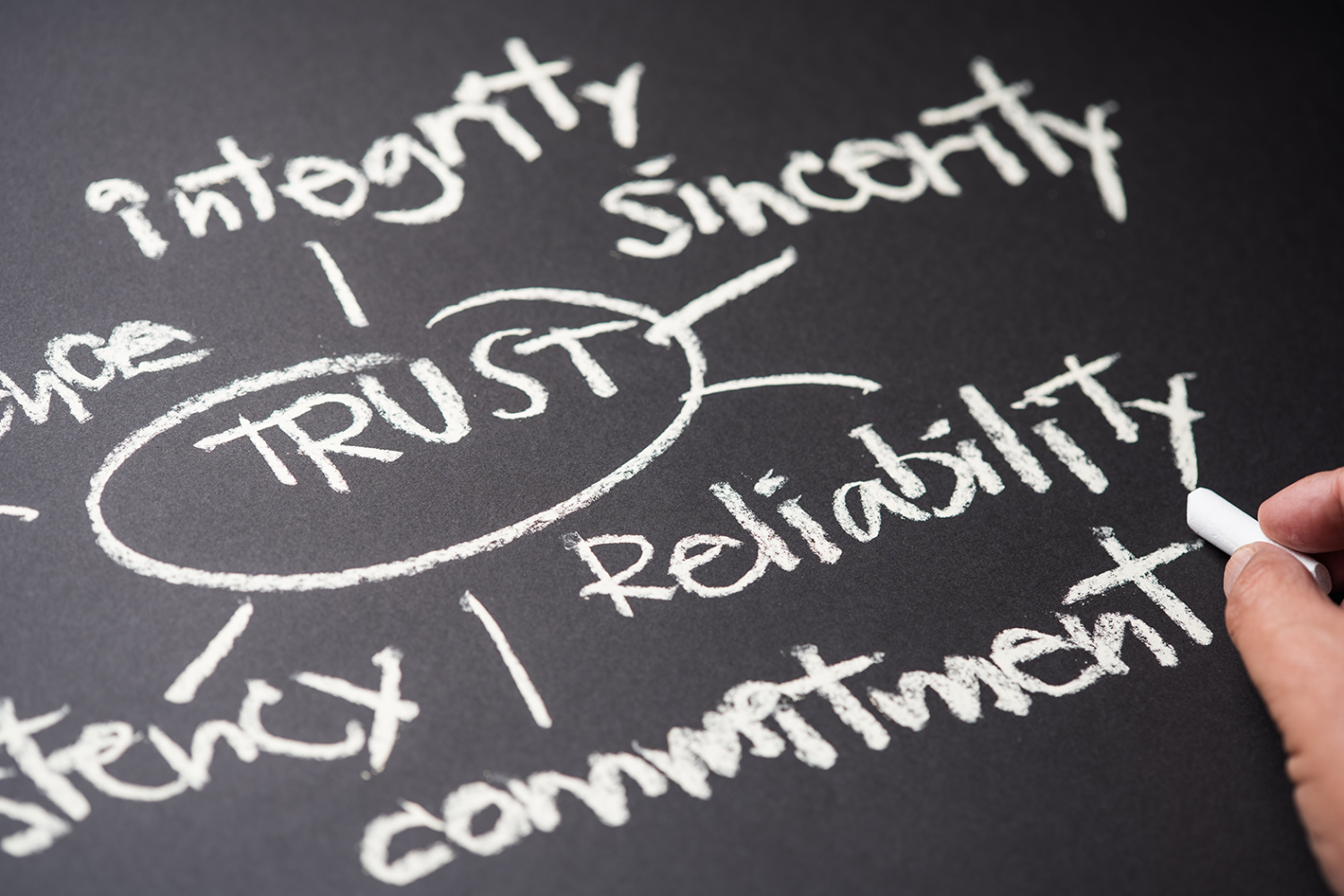Transparency and pixie dust increase trust

Image from Getty Images
I need to be transparent with you. I am a HUGE fan of the TV show Outlander. Claire Randall, an English army nurse fresh from World War II, and James (Jamie) Fraser, a Scottish Highland warrior in 1743, fall in love after Claire transports to the past when she puts her hands on a stone outcropping called the Craigh na Dun in Inverness, Scotland. Claire and Jamie work hard for their love to survive the Jacobite rising of 1745, a harrowing voyage to the New World, the American Revolution and, you know, having multiple people in their family traveling through time at various points in the story.
One of my favorite scenes of the entire show is in the first season, when Dougal MacKenzie, Jamie’s uncle and war chieftan for the Clan Mackenzie, asks Claire, a woman who has literally shown up out of nowhere, to take a drink from St. Ninian’s Spring, also known as Liar’s Spring. He then commands her to verbally confirm once again that she is not an English spy. Dougal and others at the time believed that those who drank from Liar’s Spring and then told an untruth would have their insides burned out by the magical power of the waters. Before the drink, Dougal eyed Claire warily. After the drink, he eyed her slightly less warily.
The act of drinking the water, while absurd from Claire’s perspective, helped to build trust between her and Dougal. Dougal said as much afterwards. He told Claire he would have been happy to have the waters kill her if she had been lying (Dougal was not the friendliest of fellas). From then on, Claire and Dougal had a complicated but more trusting relationship built around their shared love for Jamie.
In today’s age, all our proverbial St. Ninian’s Spring, our faith and trust in one another, has pretty much dried up. We live in an age of deep distrust. Distrust of data, distrust of expertise, distrust of intention, distrust of what we see and hear, distrust of those outside our bubbles and silos. We all feel like what Claire must have felt like suddenly back in the 1700s trying to navigate a strange, unsettling environment after a foundational understanding of what reality really is has disappeared.
Shifting back to a high-trust society isn’t going to happen overnight. That new age will only manifest itself through thousands of discrete acts of trust on the personal and local level. Committing to develop trust within our families, our workplaces and our communities is key to reinvigorating trust at a state, national and global level. And one way to strengthen trust within our homes, workplaces and towns is communicating with transparency, a power skill important for us to master.
What are the components of trust?
We don’t often think about the mechanics of trust. We assess trust with a “gut reaction,” with a feeling of “trustworthiness.” One of my favorite hack writer tropes is when a character says something like, “I don’t know what it is, but there’s something I don’t trust about that guy.”
While emotions do play some part in establishing or assessing trust, there are clear sub-actions that help to develop trust. In their 2024 study “Transparency in the Workplace,” global consulting firm Deloitte analyzed “over 400,000 survey responses with customers and workers across nearly 500 brands, in-depth focus groups, conversations with leaders committed to building trust and case studies exploring situations when trust was won or lost.”
From that analysis, Deloitte condensed the components that create trust into four main categories. Directly quoting their report, the categories are:
- Humanity. Demonstrating empathy and kindness and treating everyone fairly.
- Capability. Creating quality experiences, products and/or services.
- Reliability. Consistently delivering on promises and experiences.
- Transparency. Openly sharing information, motives and actions in straightforward and plain language.
In previous columns, I’ve talked about empathy, capability and reliability in the context of power skills. It’s time to explore transparency in communication and its impact on organizational effectiveness.
What is transparent communication?
In April 2020, Jaimie Hutchison, associate director of engagement at Michigan State University’s University Health and Wellbeing WorkLife Office, hosted a webinar entitled
“Psychological safety and transparent communication at work: Strengthening collaboration and innovation.” During that webinar, Hutchison laid out concisely what transparent communication is in the workplace. She defined transparent communication as “the act of both good and bad information being shared upward, downward, and laterally in a way that allows all to see the why behind the words.”
Upward transparent communication means team members can communicate both good and bad information to their managers. Downward means managers and senior leaders can communicate good and bad information with their employees. Lateral means colleagues can share good and bad information amongst themselves.
Each of these directions requires appropriate channels for communication, whether they are data dashboards, one-on-one meetings, anonymous surveys or idle office chatter, amongst many other available workplace communication vehicles. The most important aspect is that no matter what the channel is, people are sharing honestly about both positive information (“We just made the sale!”) and negative information (“We just lost the sale!”)
Why does transparent communication build trust?
When lost in the desert, one’s throat grows parched. When living in an age of low trust, people long for those circumstances to change. The 2024 Deloitte survey found that “86% of workers surveyed and 74% of leaders surveyed say an increasing focus on trust and transparency in the relationship between workers and the organization is very or critically important. In fact, this trend is ranked highest in terms of importance of the seven trends studied in our survey and was identified as the trend that would have the greatest impact on an organization’s success, both this year and in the next three years.”
But while there is a strong yearning for trust and transparent communication in the workplace, much like that drink of water amidst the sands, many say that transparent communication is lacking within their own professional setting. In a recent Gallup Poll on how companies communicate with their employees, only 27% of respondents felt their supervisors kept them updated about current trends at work. In that same survey, only 29% said their managers actively supported them through changes. That shows us that there is a major discrepancy between the hope for trust and transparency and the actualization of that trust and transparency.
That hope isn’t a vague naivete in the way we often characterize hope and change. Lack of transparent communication has real-world implications on the success of an organization. Again, according to Deloitte’s research:
- Companies deemed trustworthy tend to outperform their competitors by up to four times when measured by market value.
- Shares of companies graded trustworthy by Trust Across America and the Initiative on Quality Shareholders have outperformed the S&P 500 by 30% to 50% over recent five-year periods.
- Workers in high-trust companies are 50% less likely to leave, 180% more likely to be motivated, 140% more likely to take on extra responsibilities, and are generally more productive, more satisfied with their jobs and healthier.
What is it about transparent communication that builds trust? Hutchison provides some examples from her 2020 webinar:
- Employees appreciate being in the loop soon after their leaders or coworkers learn information.
- Communicating to employees or coworkers in a timely manner gains their trust, gives employees time to absorb the information, gives them a full picture of the situation and gives employees the information that may affect their job, thus allowing them to adjust their work if needed.
- Straightforward communication about the unit’s mission will give employees a clear understanding of their goals.
- Increasing transparent communication in the workplace can lead to happier employees in a more collaborative environment, allowing the unit’s work to be done more efficiently.
When people feel psychologically safe, when they believe they have the information they need to perform in their role and when they understand how the work they do connects back to the mission, they and the organization will perform better. Keeping people in the dark just means it is going to be easier for them to run into things.
How can you improve your communication transparency skills?
If you are ready to start being part of the solution to moving us back to a high-trust society, there are concrete steps you can take within your professional and personal life.
Zachary Amos, features editor at ReHack magazine, shared some really common-sense actions you can take in his 2025 article in Forbes entitled “Transparent Communication In The Workplace Is Essential—Here’s Why.” Amos laid out seven steps you can take to model transparent communication:
- Be clear and truthful. Be direct throughout all messaging and avoidcomplex language and industry jargon.
- Explain the reasoning behind decisions. If employees do not understand what motivates leaders to make decisions about the company and workflow, eventually they may begin to feel indignation or fear without being given a reason for particular actions.
- Provide regular updates. Provide regular updates about the company and team if they want to cultivate trust among employees so that employees do not become unsure about what they’re supposed to be doing and disengage.
- Reinforce purpose. Reinforce the purpose of hard work and the value of employees’ contributions to motivate teams.
- Demonstrate empathy. Empathetic leadership matters to employees and can help managers craft the correct messaging for teams.
- Embrace and act on feedback. Encourage teams to offer feedback. This means creating a safe and comfortable space where they know there won’t be repercussions.
The seventh tip may run a bit counterintuitive compared to the previous six but is just as important:
- Know the limits to transparency. Avoid oversharing personal details that are unrelated to what the team is trying to accomplish and discussing confidential information or internal matters like negotiations, potential mergers, or restructuring, to avoid causing undue anxiety amongemployees.
All of us who work in the health care field, whether interacting directly with a patient or supporting those who do, understand that the mission and purpose driving our work is to take care of others and ourselves when we need care.
When you are in the midst of inter-team struggles, battles with meeting key performance indicators and equipment breakdowns, it can be very easy to disconnect from that mission, to turn inward. But consider these tips for transparent communication in the light of a visit to a doctor’s office. If, God forbid, the doctor discovers you’ve got a serious disease, you would want them to be clear about the news, explain the reason behind their treatment recommendations, provide updates on test results, remind you that the treatment is to help keep you alive, demonstrate empathy about your situation, respond to your own thoughts on what is happening and not go into minute details that are not important. If this behavior makes sense when it comes to caring for people in a health care setting, it should also make sense when it comes to caring for people in an organizational setting.
“If the evils of the past canna hinder us — neither then shall any fears of the future.”
- Jamie Fraser, Outlander Season 3, Episode 10
Mark me. We will find a way back to trusting one another. To look into another’s eye and see ourselves. To remember that, “To err is human, to forgive, divine.” To remember what Jane taught us in “Peter Pan: Return to Neverland” that, “All the world is made of faith, and trust and pixie dust.”
Have faith that humanity is a common feature we share. Trust that if we speak with transparency and listen with empathy, we may connect better with those whose lived experiences are different than our own. And know that the pixie dust needed to foster a high-trust society, like Tink herself, only has power if we believe it does. So, believe.
Adam Bazer, MPD, senior director of thought product development, ASHE.





